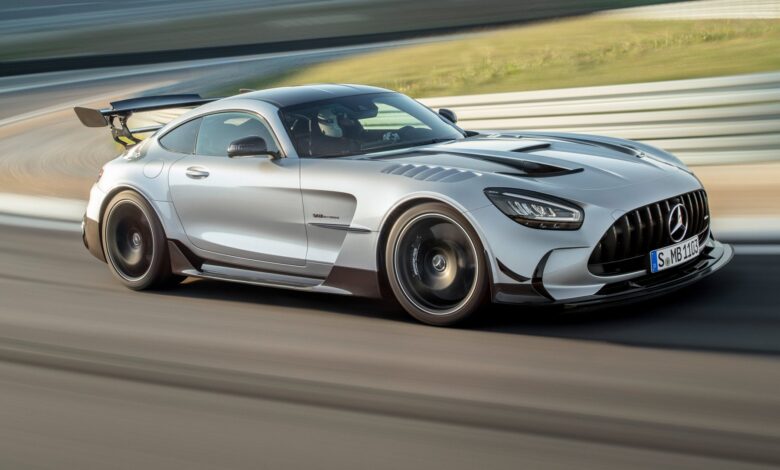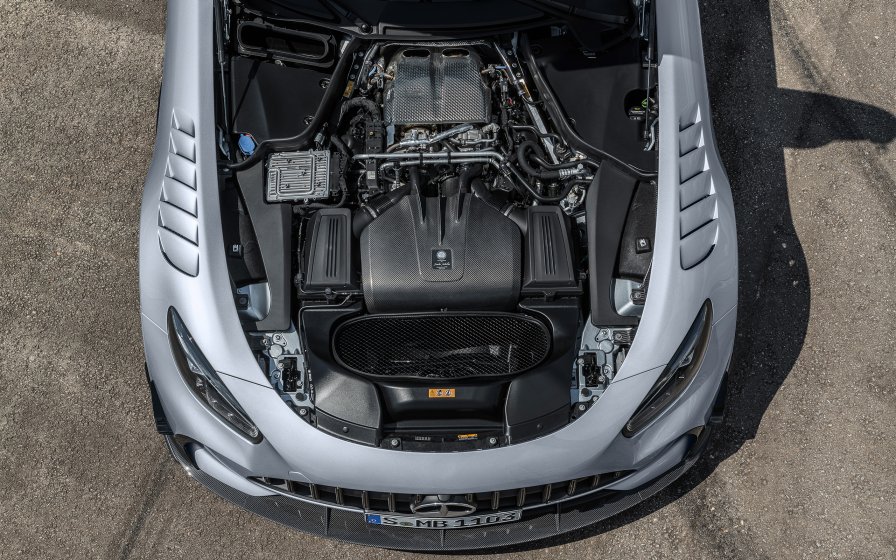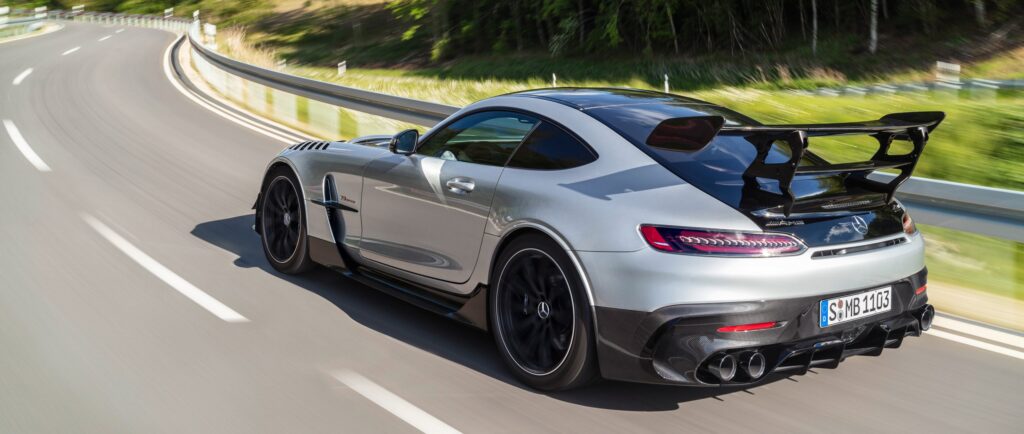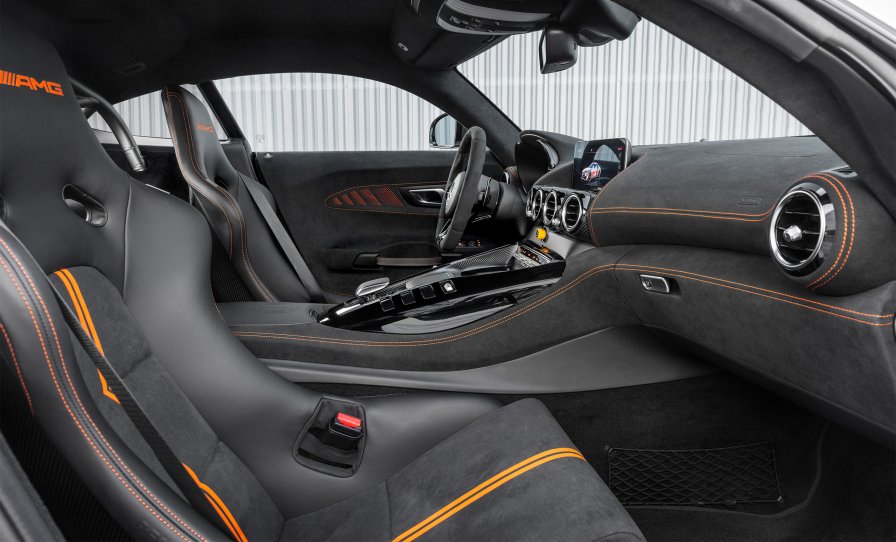The new Mercedes-AMG GT Black Series Is Here

At Mercedes-AMG, the Black Series has been synonymous with a very special type of car since 2006: uncompromisingly sporty, with an expressive design and the most consistent technology transfer from motorsport to series production. Black Series models are exclusive automotive rarities. They have not been developed to gather dust in collectors’ garages, but for high-speed use on race tracks, despite being approved for roads. The AMG GT Black Series represents a new highlight in this tradition: It is the most powerful Mercedes-AMG with a V8 series engine and can thus be individually adapted to the special conditions of various race tracks in a more versatile way than ever before.

In order to emphasise the redefinition of the super sports car, the engine specialists in Affalterbach have once again extensively further developed the tried-and-tested 4.0-litre V8 biturbo unit – in addition to it already being renowned for excellent driveability, power delivery and torque progression. The specifications were clear: Significantly more power than the previous flagship model of the AMG GT family, an even more agile throttle response, maximum torque – all of which meant that a radical change was needed in the form of a new, ‘flat’ crankshaft.
Different designs of V8 engines

The design of a V8 engine gives designers plenty of room to play with in one key element: the crank arrangement on the crankshaft. This influences the characteristics of the engine. There are usually two variants in V8 engines: the ‘cross plane’ where the crankpins of the four pairs of cylinders are at 90-degree angles to each other, which AMG has used in all previous V8 engines, or the ‘flat crankshaft’, where all crankpins are on the same plane with a 180-degree offset (‘flat plane’).
If you look at the front of a cross-plane crankshaft, you will be able to identify the cross that gives it its name. The benefits of these crankshafts are superb smoothness and high torque at low rotational speeds. The characteristic sound is another hallmark feature of the cross-plane V8 engine. In order to make optimal use of the displacement and therefore the performance potential in the case of the 4.0-litre V8 biturbo engine, the AMG engineers have essentially moved the exhaust side into the hot internal V of the two cylinder banks in the V8 engine.
Uniformly oscillating gas columns for even more power
Another way of increasing performance is by using a ‘flat’ crankshaft. In the flat-plane V8 engine, it looks like an inline four-cylinder model – except for the wider crankpins, which have two connecting rods each in the V8. Ignition in the flat-plane V8 jumps from one cylinder bank to the next, which further improves the gas cycle. The characteristic firing order with a 180-degree crankshaft angle offset is 1-8-2-7 4-5-3-6. This creates uniformly oscillating gas columns in the exhaust tract and on the intake side, whose resonance can easily be used to increase performance. The greatest advantage is an even more agile throttle response.
The most powerful V8 series engine from Mercedes-AMG
The new GT Black Series engine is based on the AMG 4.0-litre V8 biturbo engine with dry sump lubrication, but it has been given the new internal code M178 LS2 due to the numerous modifications. It achieves 537 kW (730 hp) at 6700-6900 rpm and delivers a maximum torque of 800 Nm at 2000-6000 rpm. New camshafts and exhaust manifolds are adapted to the new firing order and improve the gas cycle further.
Both twin scroll exhaust turbochargers are mounted in anti-friction bearings, as in the top-of-the-range four-door AMG GT Coupé, which optimises their throttle response even further. However, in the Black Series, the turbochargers have been given a larger compressor wheel, meaning that both can deliver a total of 1100 kg air per hour. By way of comparison: The figure is 900 kg/h for the AMG GT R. 7000 rpm is not critical as a continuous speed, the speed is limited at 7200 rpm. And the larger intercoolers guarantee that they always keep the charge-air temperature within the best possible range. The unique standing of the new engine is also reflected in the engine badge, which is kept in black.

0-200 km/h in under nine seconds
What does the engine do for the AMG GT Black Series? It gives it a completely independent character, which is not only reflected in the type of power delivery, but also in its very particular sound pattern. And it enables highly impressive driving performance: the two-door vehicle shoots from 0 to 100 km/h in 3.2 seconds, and to 200 km/h in under nine seconds. The top speed is 325 km/h, although only on cordoned-off racetracks.
Modified AMG SPEEDSHIFT DCT 7G transmission
Power is transmitted to the rear wheels via the seven-speed AMG SPEEDSHIFT DCT 7G dual clutch transmission, which is located on the rear axle in a transaxle arrangement for optimal weight distribution, as is the case for all AMG GT models. It has been modified for use in the AMG GT Black Series and adapted to the increased torque of 800 Nm. The previous limits governing shift performance and response time have been extended, making them more suitable for racetracks.
This all adds up to very different handling characteristics, as not only is the accelerator and engine response more agile – the drive programs, start-up characteristics and gear changes are, too. The Race Start function is also now even more impressive, thanks to the increased starting revs, the more sensitive wheel slip control and the sports tyres fit for the racetrack. Furthermore, the transmission cooling has been adapted to the tougher requirements, and the transmission ratios have also been slightly modified.
The ‘torque tube’ creates the connection between the engine and the transmission. It is made of carbon fibre and, at just 13.9 kilograms, is around 40 percent lighter than its already weight-optimised aluminium counterpart in the AMG GT. As a structural component of the transaxle drivetrain, it creates an extremely flexurally and torsionally stiff connection between the engine and the transmission. It permits a very direct connection of the drivetrain that is favourable to driving dynamics and also plays a role in the vehicle’s balanced weight distribution. The drive shaft which rotates inside is also made from light carbon fibre.
Sophisticated aerodynamics for incredibly high driving dynamics
The sophisticated aerodynamics not only make a significant contribution to high driving dynamics and stability on fast circuits. As with the AMG GT R and AMG GT R PRO, aerodynamics experts and designers have worked in close collaboration, as ‘form follows function’ applies more than ever in the case of the Black Series.
The similarity to the AMG GT3 and AMG GT4 racing cars is visually and technically stronger than ever before. It starts already with the new, significantly larger cooling air inlet grille, which stems directly from the AMG GT3 racing car. The radiator trim has vertical struts in dark chrome. Because the wheel arch coolers are now also supplied with air directly via the central intake, there is no longer a need for the two additional outer air inlets in the front apron. Sickle-shaped flics optimise the flow of air here, which not only increases downforce at the front axle, but also improves brake cooling. The ‘air curtains’ control and direct the flow towards the wheels. Together with the flics in front of the wheels, this serves to reduce the drag coefficient and increase downforce. The new design language therefore combines maximum cool air efficiency with lower air resistance and an increased level of downforce at the front.
The carbon-fibre front splitter has two manually adjustable settings (Street and Race – Race exclusively for use on racetracks), and can therefore be adapted to meet various track requirements. When extended forward (Race position), a front diffuser in the shape of an upside-down aerofoil profile is then created under the front end. Depending on the driving speed, this element is lowered even further by the rising negative pressure, which significantly accelerates the air flow on the underbody, creating a ‘Venturi effect’, which also draws the car closer to the road and increases downforce on the front axle. The driver can feel the benefits in the steering: The Black Series can be steered even more precisely when cornering at high speed and exhibits even better directional stability. Especially during fast cornering and under high lateral acceleration, the vehicle delivers an agile response with clear steering wheel feedback – while remaining easily controllable at all times. If the front diffuser is in the Race position, the downforce at the rear axle can also be increased further by the new rear aerofoil concept.
Bonnet with two large exhaust air openings improves aero-performance
Another direct derivative from motorsport is the new carbon-fibre bonnet, with two large exhaust air outlets made from black-finished carbon surfaces. The large outlets guide the warm air, which is fed from the diagonally positioned cooling pack, out of the engine compartment. This technology is also directly derived from motorsport and increases the overall downforce. At the same time, the air resistance is reduced, and the air mass flow for cooling the engine is optimised. The air is also specifically guided around the A-pillars and side windows to the rear, where it increases the efficiency of the new rear aerofoil concept.
The seamlessly integrated louvres (air slots), with five fins in the body colour and exhaust air openings behind the wheels in the front carbon-fibre wings, help to increase downforce at the front axle by means of effective wheel arch ventilation. The air flowing around the vehicle is also optimised by the new, significantly larger and wider side sill panels with black carbon-fibre elements, which merge into vertical blades at the front and rear. Additional cooling air ducts are integrated into the side sill panels for brake cooling at the rear axle.

Two-stage rear aerofoil concept
The rear view is characterised by the new rear apron with a large diffuser, two rounded twin tailpipe trims on the outside left and right, side wheel arch ventilation, and the innovative rear aerofoil concept. Both aerofoil blades are made from carbon fibre, can be mechanically adjusted and therefore adapted to various track conditions. The second, lower positioned blade was made particularly small and narrow because this is ideal for the air arriving from the front of the car. On delivery both aerofoil blades are set flat. The light yet robust carbon-fibre aerofoil supports, painted matt black and specially designed based on extensive simulations also increase aerodynamic efficiency. They are bolted to the carbon-fibre tailgate, which is also black.
Another fascinating detail: the movable flap in the upper blade. This active aerodynamic element is electronically adjusted by 20 degrees, to suit the driving situation and selected AMG DYNAMICS mode, and thus influences on the longitudinal and transverse dynamics. In a flat position, it reduces the air resistance, to help reach the top speed more quickly. In the inclined position, the flap improves braking performance and cornering stability thanks to increased downforce at the rear axle.
Various actuation strategies were developed for the active aerodynamics element, depending on the AMG DYNAMIC SELECT drive program chosen and the AMG DYNAMICS levels Basic, Advanced, Pro or Master. Some of these strategies also involve driving dynamics recognition: when dynamics are detected (such as sharp braking, accelerating, cornering, steering) the flap is extended for as long as dynamics continue. After that there is a brief hold time of three and a half seconds, and the flap retracts again.
Master in the RACE drive program: The flap is permanently inclined and extended from 20 km/h to 250 km/h. When the speed exceeds 250 km/h, it retracts in order to reduce the air resistance and thus reach the top speed more quickly. However, if the driver brakes suddenly or steers into a corner, the flap immediately returns to its extended position in order to optimise braking and cornering thanks to increased downforce and air resistance. Irrespective of this the flap can also be retracted or extended manually by the driver using a separate button in the centre console.

The interior design emphasises the pole position of the AMG GT Black Series: exclusive nappa leather is combined with sporty DINAMICA microfibre in black with orange contrasting topstitching. The instrument panel and the newly designed lightweight door panels, which are now equipped with loop pull handles instead of conventional handles, are trimmed in black DINAMICA microfibre. Further orange contrasting topstitching, matt black carbon-fibre trim and the Interior Night Package add further striking highlights. The AMG carbon-fibre bucket seats (not available in the USA, Canada and China) combine low weight with optimum lateral support. In the USA, Canada and China, the Black Series is equipped with AMG Performance seats as standard. The interior is also optionally available with grey contrasting topstitching.
Technical data at a glance
| Mercedes-AMG GT Black Series | |
| Engine | 4.0-litre twin-turbo V8 |
| Displacement | 3982 cc |
| Output | 537 kW (730 hp) at 6700-6900 rpm |
| Peak torque | 800 Nm at 2000-6000 rpm |
| Drive system layout | Rear-wheel drive |
| Transmission | AMG SPEEDSHIFT DCT 7G |
| Combined fuel consumption | 12.8 l/100 km* |
| Combined CO2 emissions | 292 g/km |
| Efficiency class | G |
| Acceleration 0-100 km/h | 3.2 s |
| Top speed | 325 km/h |



